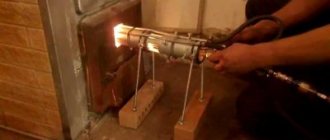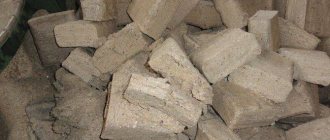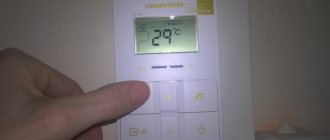When is it time to clean a gas boiler?
The frequency depends on the quality of the water and fuel that circulate in the boiler. Signs of a blockage may include:
- The gas boiler is working, but the house is still cold.
- You have started paying significantly more for gas.
- You hear the smell of burnt fuel.
And in order to deal with one of the problems and clean a gas boiler at home, you need to understand its structure. You have to remove the following nodes:
- Igniter (responsible for igniting the burner).
- Burner and nozzles.
- Filter (cleanses fuel from impurities).
- Heat exchanger (heats the coolant before it travels through the circuit).
- Firebox.
- Chimney.
Flame control
As I said above, the ionization electrode controls the presence of a flame on the gas burner to avoid emergency situations. That is, there is nothing fundamentally new in the method of such control - the whole process is based on the usual physical properties of gases. All ionization electrodes are connected to an automatic combustion control system, where a sensitive threshold is set. The positively charged particles create a current of only a few microamps, but this is enough to keep the valve open, and the absence of current causes it to close.
The device is a metal rod, partially enclosed in a ceramic shell, and the impulse is transmitted using a special cable with connectors attached to the machine. The operation of the ionization sensor directly depends on its cleanliness, that is, a dirty rod attracts positively charged particles worse, therefore, there may be a false absence of a pulse, which will lead to blocking of the gas flow. Another hindrance can be excess air content in the fuel - this also needs to be controlled.
For reference: the metal rod for the ionization (control) electrode is made of an alloy of iron (Fe), chromium (Cr) and aluminum (Al). This composite can withstand temperatures up to 1400°C.
Ionization and ignition electrodes
In addition to the ionization device, boilers have one or two ignition electrodes, which are responsible for creating a flame on the burner - when a signal is received, the rod sparks and the gas ignites. In earlier boilers, a thermocouple was used for this purpose, but today this is a rarity, although there are heating units that combine an ionization electrode with a thermocouple and photosensors added to this group.
In new models of gas boilers, the ignition and ionization electrode is installed as a single device, that is, two in one. Such a device operates instantly - all operations to block and open the valve, as well as ignite the flame on the burner, are performed by one device, which significantly increases the speed of processes. This device can be easily removed for maintenance, which may involve cleaning the rod with sandpaper or a brass brush, or completely replacing the sensor.
Ionization electrode does not see flame
There may be cases when you start a gas boiler, hear the characteristic clicking of the ignition electrode, the burner lights up, but after about 10-12 seconds the process stops and if there is an electronic display, an error code appears there. When you try to reset, the error is reset, but when you turn it on, everything repeats again. The problem most often lies in the fact that the flame control (ionization) electrodes do not see the plasma, that is, positively charged particles do not reach the metal rod of the device. The time allocated for flame detection expires (10-12 seconds), and an emergency situation is triggered, in which the valve immediately blocks the gas flow.
In such cases, contamination of the metal rod is very likely, which means that cleaning the ionization electrode with No. 0 sandpaper or a brass brush is required. When there is no foreign deposit on the metal surface, it will begin to attract positively charged particles. In addition, you need to carefully examine the ceramic insulator and if you find even a small crack on it, then again there is a problem with the electrode. The flame control principle is broken and the device must be replaced.
Another reason may lie in the burner itself. The flame from it should, as it were, wash the ignition and ionization electrodes, but if it is short or flares up jerkily, it means that the burner is clogged and needs to be cleaned. To do this, the burner must be dismantled by unscrewing 2-3 bolts (the number of fasteners differs on different models) and blown with compressed air, which will remove carbon deposits from the channels (you can use a car pump). This operation is very simple and can be done independently, without the help of a specialist. A third variant of the malfunction is also possible - problems with the control board. In such situations, you cannot cope on your own - the board will have to be removed and sent for testing.
Burner and nozzles: learning to clean
The burner is one of the important parts, since if it is clogged, gas costs will increase sharply. To clean the burner of a gas boiler, you need:
- Turn off the gas.
- Remove the burner from the boiler.
- Remove the injectors. And it’s better to take a picture of them before doing this, so that you can easily return them to their place later.
- Clean the injectors with a soft brush.
- Then remove dirt from the burner.
- Blow out the burner holes. A pump from a bicycle or car will help with this.
- Place the nozzles back into the burner.
- And return the burner to the boiler.
It is advisable to clean the gas boiler burner before each heating season.
Special cleaning equipment
A booster (installation for washing heat exchangers) is a rather rare and expensive equipment (40-90 thousand rubles), which is simply unprofitable to buy for personal purposes, no matter how often you clean it. It is a container with a built-in circulation pump that supports a change in flow direction - reverse, which increases the efficiency of washing. The devices are resistant to any reagents used.
PIPAL PUMP ELIMINATE 20 V4V
One of the best Italian-made units. It has compact dimensions and optimal performance - 2600 l/hour (44 l/min). Tank volume – 18 l, permissible pressure – 1 bar. Known for its simplicity and reliability.
BWT Cillit SEK 28
An equally well-known, proven German-made installation. Capacity – 2400 l/hour, the operating principle is no different from the previous installation, designed for higher temperatures – up to 60°C. It has even more compact dimensions and a convenient handle for transportation.
How to clean a gas boiler filter?
As a rule, a gas filter is installed in front of the steam part on the line. And it serves to clean the fuel from impurities and dirt, due to which more soot is formed and the chamber and chimney become covered with scale faster.
To clean the gas filter you need:
- Remove the cover.
- Unscrew the plug from the flange.
- Remove the cassette or mesh, depending on what filter you have.
- Shake, blow or rinse with solvent.
- Put it in place.
Prevention
Prevention is necessary to prevent scale, which is the main scourge of geysers (for example, such as Zanussi water heaters). It appears not only as a result of salt deposits from hard water, but also as a result of constant high temperature in the device. To ensure that the pipes are clogged with this “muck” as little as possible, it is necessary to set the optimal temperature.
Another way to prevent scale is to install water purification filters or electric softeners. They do not allow harmful salts to pass through, allowing the heat exchanger pipes to last longer. However, the cleanliness of the filter and electric softener also needs to be monitored.
Cleaning the heat exchanger
The rate of heating of the room depends on the cleanliness of the heat exchanger. It shouldn't sit in your soot. And in order to clean the heat exchanger of a gas boiler at home, you need to take:
- Scraper.
- A stiff brush.
- Yorshik.
- Power tool.
Procedure:
- Shut off the gas supply.
- Remove the heat exchanger.
- Clean it with all the tools from the list.
- Put the part back.
Do not clean the gas boiler heat exchanger with sharp tools. Because if you damage it, corrosion will begin.
Often a layer of scale forms inside the heat exchanger. This usually happens due to poor quality coolant. And then the exchanger becomes clogged and the boiler does not work well. It is better to clean a Baxi or other gas boiler from scale:
- Acid.
- A ready-made preparation.
If you take sulfanilic or other acid, work carefully, as you can burn your hands or damage the knot itself.
How to remove scale?
A booster will also help clean a gas boiler from scale. This is a device that consists of several parts:
- Pump.
- Containers for funds.
- Heating element.
This is how a booster works. The product is heated in a container, and then, using a pump, it enters the heat exchanger. There, chemicals work and clean the unit from the inside, after which the spent product, along with the debris, comes out back.
The booster will help clean any pipes or heater.
Do not forget that you need to clean the heat exchanger of a gas boiler at home at least once a year. And if the coolant is weak, then even more. For example, when you use water from the tap.
If you don’t know how to clean a Navien gas boiler yourself, it’s better to call a specialist.
What solutions to use for cleaning
Acids and special products work well to remove scale accumulated on the walls of the heat exchanger:
Detex
A special liquid designed to remove traces of oxides, scale, and salts. Interacts well with products made of steel, cast iron or copper, increasing their service life
Lemon acid
Citric acid heated to 60 degrees is suitable for cleaning parts made of stainless steel, copper, and brass. The minimum concentration of the solution is 0.5%, and the maximum is 1.5%.
Oxalic acid
Clears scale and traces of rust without damaging painted parts. Suitable for all types of metal. A special product based on oxalic acid is “Solita”.
Sulfamic acid
Removes deposits that include metal oxides. Safe for most materials used in boiler assembly.
Hydrochloric acid
It has an aggressive effect on metal. It is permissible to use this substance as a last resort only for processing products made of stainless steel and copper.
The aggressiveness of the solution is reduced by additives that prevent the destruction of the metal shell of the product. It is extremely toxic, and when working with it, strict safety regulations must be followed.
Expert opinion
Grebnev Vadim Savelievich
Heating system installer
The disadvantage of chemical cleaning is the inability to control the interaction of acid not only with deposits, but also with metal elements of the boiler that are not susceptible to contamination. The harmful effects can be avoided by adding inhibitors to the acid to soften the effects of the acid.
Regular cleaning and maintenance of the gas boiler will ensure its uninterrupted operation and significantly extend its service life.
How to clean the firebox and chimney?
Combustion products remain in the firebox and on the walls of the chimney. Clean them with a brush or brushes, which you can buy in the store.
To clean a gas boiler from soot, you need:
- Turn off the gas.
- Remove the door, thermocouple, burner with nozzles.
- Remove the top cover.
- And remove the insulating sheet.
- Dismantle the chimney.
- Select a brush of the required size and clean the heat exchanger from soot. If necessary, you can even vacuum it.
- Clean the walls of the boiler with a brush and scraper.
- The pipe itself is cleaned with a brush or cable.
- Collect all nodes.
What is the difference between cleaning single-circuit and double-circuit boilers?
Mainly by volume: cleaning gas boilers with a primary heating circuit takes less time and effort. It includes maintenance of all components and components, including the firebox and chimney. The last 2 elements are also found in double-circuit boilers. Cleaning the firebox and sectional chimney is not difficult for those who independently service household appliances: contaminants are removed mechanically.
The normal functioning of the unit, or more precisely, its performance and stability of operation, depends on the condition of the chimney. The automation of modern heating boilers necessarily includes a draft control sensor; in its absence, the start of the burners (ignition) is blocked. Therefore, it is very important to keep your chimney clean.











